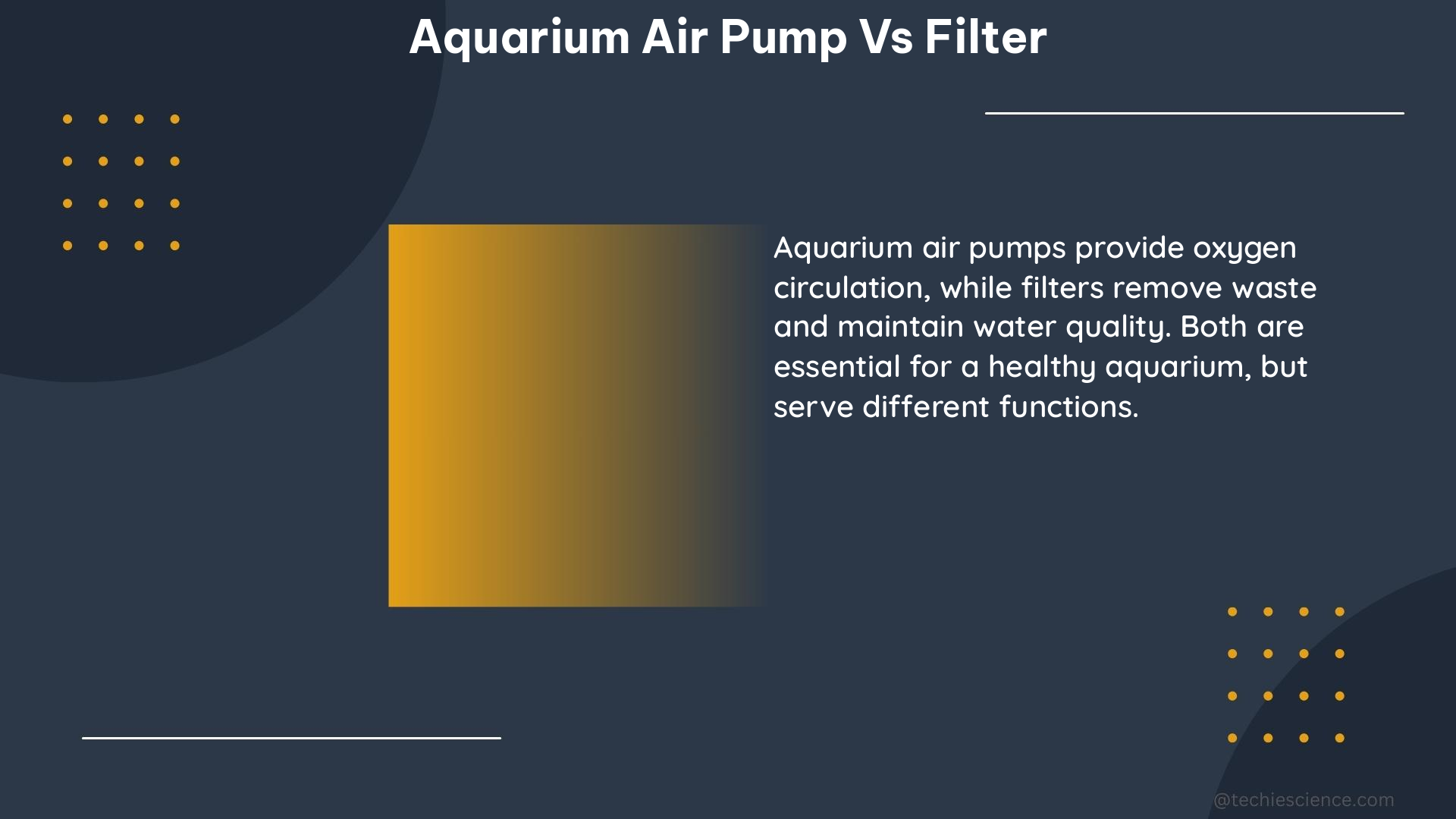Aquarium air pumps and filters are two essential components that work in tandem to maintain a healthy and thriving aquatic environment. While air pumps primarily focus on oxygenating the water, filters play a crucial role in removing waste, debris, and other contaminants, ensuring the overall water quality and the well-being of your aquatic inhabitants.
Understanding Air Pumps
Air pumps are responsible for introducing air into the aquarium water, promoting oxygenation and creating bubbles that can serve both aesthetic and functional purposes. The performance of an air pump is typically measured in Gallons Per Hour (GPH), which indicates the volume of air it can circulate.
Types of Air Pumps
- Diaphragm Air Pumps: These are the most common type of air pumps used in aquariums. They work by using a vibrating diaphragm to draw in air and push it into the water.
- Piston Air Pumps: These air pumps use a piston mechanism to draw in and push out air, often providing a more consistent and reliable airflow compared to diaphragm pumps.
- Magnetic Air Pumps: These air pumps utilize a magnetic motor to power the air movement, offering a quieter operation and increased energy efficiency.
Factors to Consider when Choosing an Air Pump
- Tank Size: The size of your aquarium will determine the appropriate air pump size. As a general rule, you’ll need an air pump that can provide at least 1 to 2 times the volume of your tank per hour.
- Air Pump Capacity: The air pump’s capacity, measured in GPH, should be sufficient to meet the oxygen demands of your aquarium inhabitants and any additional equipment, such as protein skimmers or air-driven decorations.
- Noise Level: Some air pumps can be quite noisy, so consider the noise level if you want a quieter operation.
- Energy Efficiency: Look for air pumps with energy-efficient designs, as they can help reduce your electricity costs in the long run.
Understanding Aquarium Filters

Aquarium filters are responsible for removing waste, uneaten food, and other debris from the water, ensuring a clean and healthy environment for your aquatic life. Filters are typically measured in Liters Per Hour (LPH) or Gallons Per Hour (GPH), indicating the volume of water they can process.
Types of Aquarium Filters
- Hang-on-Back (HOB) Filters: These filters are designed to hang on the back of the aquarium, drawing water in and passing it through various filtration media.
- Canister Filters: Canister filters are external filters that sit outside the aquarium, providing a larger filtration capacity and more advanced filtration options.
- Sponge Filters: Sponge filters use a porous sponge material to trap debris and provide biological filtration, often powered by an air pump.
- Undergravel Filters: These filters are installed beneath the substrate, drawing water through the gravel and providing both mechanical and biological filtration.
Factors to Consider when Choosing an Aquarium Filter
- Tank Size: The size of your aquarium will determine the appropriate filter size. As a general rule, the filter’s flow rate should be 4 to 8 times the volume of your tank per hour.
- Filtration Media: Filters often use a combination of mechanical, chemical, and biological filtration media to remove different types of waste and contaminants.
- Maintenance Requirements: Consider the filter’s maintenance requirements, such as how often the media needs to be cleaned or replaced, to ensure efficient operation.
- Noise Level: Some filters, particularly canister filters, can be relatively noisy, so consider the noise level if it’s a concern.
Combining Air Pumps and Filters
While air pumps and filters serve distinct functions, they can work together to create a balanced and healthy aquarium environment. The combination of these two components can provide the following benefits:
- Improved Oxygenation: Air pumps introduce oxygen-rich air into the water, which is essential for the health and well-being of your aquatic inhabitants.
- Enhanced Water Circulation: The bubbles created by air pumps can help to improve water circulation, ensuring that the filter’s intake can effectively draw in and process the water.
- Efficient Waste Removal: Filters remove waste, uneaten food, and other debris, while the air pump’s bubbles can help to break down and distribute these materials, making them more accessible to the filter.
When setting up a new aquarium, it’s crucial to cycle the tank thoroughly before adding fish. This process involves establishing a healthy bacterial colony, which can take around a month. During this time, you can introduce an air pump and filter to help create a stable and balanced environment.
Conclusion
Aquarium air pumps and filters are both essential components for maintaining a healthy and thriving aquatic environment. While air pumps focus on oxygenating the water, filters play a crucial role in removing waste and debris, ensuring the overall water quality. By understanding the specific needs of your aquarium, including tank size, fish species, and plant life, you can choose the right combination of air pumps and filters to create a balanced and sustainable ecosystem for your aquatic inhabitants.
References:
- Difference between Pumps and Filters
- What’s the Difference Between an Aquarium Filter and an Air Pump?
- Air Pump, Water Pump, Water Filter – What’s the Difference?
- What is an Aquarium Air Pump and is it Necessary?
